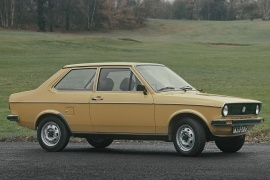VOLKSWAGEN Derby Models/Series Timeline, Specifications & Photos
First production year: 1977
Engines: Gasoline
Body style: Hatchback
The '70s were the years of exploration for Volkswagen, and it tried to get more attention from the market, offering the Polo in a three-box shape, named as Derby.
After its unexpected and huge success recorded with the Golf, the management was happy. The compact hatchback was a cash-making machine and provided financial support for other projects. The first step was to take the Audi 50, which was too expensive for that market segment, and turned it into a Volkswagen Polo. Then, since the customers started to ask for sedans, the R&D department added a trunk to the small hatchback, and thus it created the Derby. It was another big hit, outselling the three-door Polo in 1977.
Volkswagen said that the Bertone Design Studio was involved in the design process, but its contribution was smaller. Unlike the Golf, which Giugiaro designed, the little Derby received the Polo's front side up to the C-pillars, and Volkswagen's designers added the trunk. The round headlights and the black plastic grille with horizontal slats were similar.
Inside, the design was bland, with a straightforward dashboard design, interrupted by a pair of vents in the middle. Underneath it, the carmaker added a shelf that covered the entire car's width. The instrument panel was as simple as possible, with only a speedometer and a fuel-level gauge. For other important information such as coolant temperature or oil pressure, Volkswagen relied on warning lights. It was good enough for four adults.
Under the hood, the German carmaker introduced the Derby with a 1.1-liter engine. Later on, it added a 0.9-liter and a 1.3-liter engine. All versions were paired to a four-speed manual gearbox.
